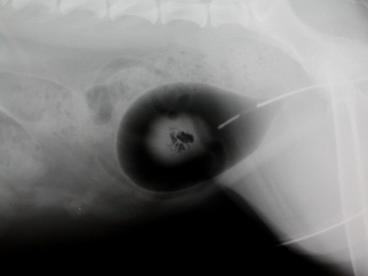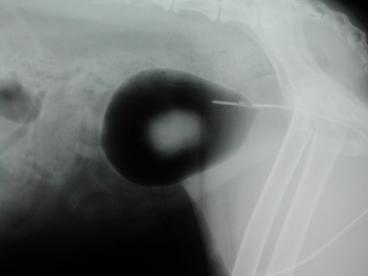Image of the month
Are xanthine stones dissolvable?
The answer depends on the underlying cause. Xanthine, an intermediate-byproduct of purine catabolism, is rarely found in urine or stones because it is metabolized to uric acid and then allantoin, a water soluble end-product that is excreted in urine. Hereditary Xanthinuria is a rare autosomal recessive disease caused by loss of xanthine dehydrogenase (XDH) or molybdenum cofactor sulfurase (MOCOS) genes. Acquired Xanthinuria is a potential adverse consequence of allopurinol, a xanthine dehydrogenase inhibitor administered to treat leishmaniasis and prevent urate uroliths. In acquired xanthinuria, xanthine uroliths are dissolvable. Hereditary xanthine uroliths are not dissolvable.

Case Example: Jake is a 2-year-old male Dalmatian diagnosed with urate uroliths. Following urolith removal, Jake was prescribed allopurinol (15mg/kg /day) to reduce urate stone recurrence. However, a diet change was not recommended. A 2-month recheck identified urolith recurrence (figure 1); uroliths were much larger than his previous ones. During the recheck, small uroliths were retrieved with a urinary catheter and submitted for quantitative analysis. Recurrent stones were composed of 100% xanthine. With this new information, allopurinol was discontinued and Jake was prescribed a low purine, urine-alkalinizing diet (Prescription diet u/d). Radiographs taken one month later revealed that all xanthine stones had dissolved (figure 2). To prevent future urate urolith recurrence, allopurinol was prescribed at a lower dose (7 mg/kg/day) and the low-purine diet was continued. Read more on allopurinol and urate uroliths (PDF).

Figure 1. Double contrast cystogram showing xanthine uroliths in the urinary bladder of a male Dalmatian following allupurinol administration.

Figure 2. Double contrast cystogram of the dog in figure 1 one month after stopping allopurinol and feeding a low purine diet. Xanthine uroliths rapidly dissolved.
See also our Canine xanthine recommendations (PDF)